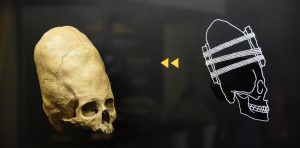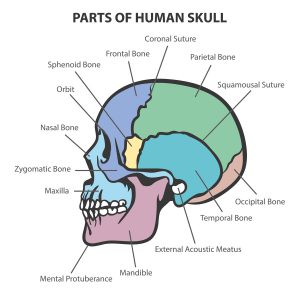When Did Modern Human Brains—and the Image of God—Appear?
When I was a kid, I enjoyed reading Ripley’s Believe It or Not! I couldn’t get enough of the bizarre facts described in the pages of this comic.
I was especially drawn to the panels depicting people who had oddly shaped heads. I found it fascinating to learn about people whose skulls were purposely forced into unnatural shapes by a practice known as intentional cranial deformation.
For the most part, this practice is a thing of the past. It is rarely performed today (though there are still a few people groups who carry out this procedure). But for much of human history, cultures all over the world have artificially deformed people’s crania (often for reasons yet to be fully understood). They accomplished this feat by binding the heads of infants, which distorts the normal growth of the skull. Through this practice, the shape of the human head can be readily altered to be abnormally flat, elongated, rounded, or conical.

Figure 1: Deformed ancient Peruvian skull. Image credit: Shutterstock.
It is remarkable that the human skull is so malleable. Believe it, or not!

Figure 2: Parts of the human skull. Image credit: Shutterstock.
For physical anthropologists, the normal shape of the modern human skull is just as bizarre as the conical-shaped skulls found among the remains of the Nazca culture of Peru. Compared to other hominins (such as Neanderthals and Homo erectus), modern humans have oddly shaped skulls. The skull shape of the hominins was elongated along the anterior-posterior axis. But the skull shape of modern humans is globular, with bulging and enlarged parietal and cerebral areas. The modern human skull also has another distinctive feature: the face is retracted and relatively small.

Figure 3: Comparison of modern human and Neanderthal skulls. Image credit: Wikipedia.
Anthropologists believe that the difference in skull shape (and hence, brain shape) has profound significance and helps explain the advanced cognitive abilities of modern humans. The parietal lobe of the brain is responsible for:
- Perception of stimuli
- Sensorimotor transformation (which plays a role in planning)
- Visuospatial integration (which provides hand-eye coordination needed for throwing spears and making art)
- Imagery
- Self-awareness
- Working and long-term memory
Human beings seem to uniquely possess these capabilities. They make us exceptional compared to other hominins. Thus, for paleoanthropologists, two key questions are: when and how did the globular human skull appear?
Recently, a team of researchers from the Max Planck Institute for Evolutionary Anthropology in Leipzig, Germany, addressed these questions. And their answers add evidence for human exceptionalism while unwittingly providing support for the RTB human origins model.1
The Appearance of the Modern Human Brain
To characterize the mode and tempo for the origin of the unusual morphology (shape) of the modern human skull, the German researchers generated and analyzed the CT scans of 20 fossil specimens representing three windows of time: (1) 300,000 to 200,000 years ago; (2) 130,000 to 100,000 years ago; and (3) 35,000 to 10,000 years ago. They also included 89 cranially diverse skulls from present-day modern humans, 8 Neanderthal skulls, and 8 from Homo erectus in their analysis.
The first group consisted of three specimens: (1) Jebel Irhoud 1 (dating to 315,000 years in age); (2) Jebel Irhoud 2 (also dating to 315,000 years in age); and (3) Omo Kibish (dating to 195,000 years in age). The specimens that comprise this group are variously referred to as near anatomically modern humans or archaic Homo sapiens.
The second group consisted of four specimens: (1) LH 18 (dating to 120,000 years in age); (2) Skhul (dating to 115,000 years in age); (3) Qafzeh 6; and (4) Qafzeh 9 (both dating to about 115,000 years in age. This group consists of specimens typically considered to be anatomically modern humans. The third group consisted of thirteen specimens that are all considered to be anatomically and behaviorally modern humans.
Researchers discovered that the group one specimens had facial features like that of modern humans. They also had brain sizes that were similar to Neanderthals and modern humans. But their endocranial shape was unlike that of modern humans and appeared to be intermediate between H. erectus and Neanderthals.
On the other hand, the specimens from group two displayed endocranial shapes that clustered with the group three specimens and the present-day samples. In short, modern human skull morphology (and brain shape) appeared between 130,000 to 100,000 years ago.
Confluence of Evidence Locates Humanity’s Origin
This result aligns with several recent archaeological finds that place the origin of symbolism in the same window of time represented by the group two specimens. (See the Resources section for articles detailing some of these finds.) Symbolism—the capacity to represent the world and abstract ideas with symbols—appears to be an ability that is unique to modern humans and is most likely a manifestation of the modern human brain shape, specifically an enlarged parietal lobe.
Likewise, this result coheres with the most recent dates for mitochondrial Eve and Y-chromosomal Adam around 120,000 to 150,000 years ago. (Again, see the Resources section for articles detailing some of these finds.) In other words, the confluence of evidence (anatomical, behavioral, and genetic) pinpoints the origin of modern humans (us) between 150,000 to 100,000 years ago, with the appearance of modern human anatomy coinciding with the appearance of modern human behavior.
What Does This Finding Mean for the RTB Human Origins Model?
To be clear, the researchers carrying out this work interpret their results within the confines of the evolutionary framework. Therefore, they conclude that the globular skulls—characteristic of modern humans—evolved recently, only after the modern human facial structure had already appeared in archaic Homo sapiens around 300,000 years ago. They also conclude that the globular skull of modern humans had fully emerged by the time humans began to migrate around the world (around 40,000 to 50,000 years ago).
Yet, the fossil evidence doesn’t show the gradual emergence of skull globularity. Instead, modern human specimens form a distinct cluster isolated from the distinct clusters formed by H. erectus, Neanderthals, and archaic H. sapiens. There are no intermediate globular specimens between archaic and modern humans, as would be expected if this trait evolved. Alternatively, the distinct clusters are exactly as expected if modern humans were created.
It appears that the globularity of our skull distinguishes modern humans from H. erectus, Neanderthals, and archaic Homo sapiens (near anatomically modern humans). This globularity of the modern human skull has implications for when modern human behavior and advanced cognitive abilities emerged.
For this reason, I see this work as offering support for the RTB human origins creation model (and, consequently, the biblical account of human origins and the biblical conception of human nature). RTB’s model (1) views human beings as cognitively superior and distinct from other hominins, and (2) posits that human beings uniquely possess a quality called the image of God that I believe manifests as human exceptionalism.
This work supports both predictions by highlighting the uniqueness and exceptional qualities of modern humans compared to H. erectus, Neanderthals, and archaic H. sapiens, calling specific attention to our unusual skull and brain morphology. As noted, anthropologists believe that this unusual brain morphology supports our advanced cognitive capabilities—abilities that I believe reflect the image of God. Because archaic H. sapiens, Neanderthals, and H. erectus did not possess this brain morphology, it makes it unlikely that these creatures had the sophisticated cognitive capacity displayed by modern humans.
In light of RTB’s model, it is gratifying to learn that the origin of anatomically modern humans coincides with the origin of modern human behavior.
Believe it or not, our oddly shaped head is part of the scientific case that can be made for the image of God.
Resources
- Who Was Adam? A Creation Model Approach to the Origin of Humanity by Fazale Rana with Hugh Ross (book)
- “Update: When Did the Genetic Adam and Eve Live?” by Fazale Rana (article)
- “When Did Mitochondrial Eve and Y Chromosomal Adam Live?” by Fazale Rana (article)
- “New Archeological Evidence Fills the Gap in the Biblical Case for Human Origins” by Fazale Rana (article)
- “The Oldest Art in the World” by Fazale Rana (article)
- “Sophisticated Cave Art Evinces the Image of God” by Fazale Rana (article)
- “Did Neanderthals Have the Brains to Make Art?” by Fazale Rana (article)
- “Differences in Human and Neanderthal Brains Explain Human Exceptionalism” by Fazale Rana (article)
Endnotes
- Simon Neubauer, Jean-Jacques Hublin, and Philipp Gunz, “The Evolution of Modern Human Brain Shape,” Science Advances 4 (January 24, 2018): eaao596, doi:10.1126/sciadv.aao5961.
Check out more from Reasons to Believe @Reasons.org





